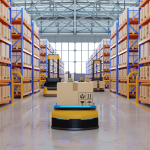As automation scales and robotics fleets expand, warehouse communication infrastructure is hitting its limits. Traditional Wi-Fi struggles to keep up with the data volume and latency requirements of densely networked machines. Now, with public and private 5G deployments advancing across North America and Europe, companies are embedding the technology directly into warehouse environments, enabling orchestration at millisecond speeds.
Legacy Networks Can’t Keep Up
Legacy warehouse networks were never designed for real-time, machine-to-machine coordination. Even modest latency or packet loss can stall AMR fleets, scramble task assignments, or trigger safety slowdowns in shared work zones. These risks are magnified during peak periods, when thousands of signals, from scanner pings to path recalculations, compete for bandwidth.
The challenge is not hypothetical. In a 2023 demonstration backed by the U.S. Department of Defense, KPMG unveiled a 5G-enabled smart warehouse system at the Marine Corps Logistics Command in Albany, Georgia. The system featured autonomous robotic inventory management, real-time machine learning for tracking, and a message brokering engine integrating over 40 solution components. The 5G architecture, running on federally owned spectrum, enabled low-latency orchestration between robots, sensors, and workers, delivering synchronized execution across a high-density, 440-pallet robotic storage solution.
What emerged wasn’t just a showcase of speed, but of operational cohesion. Robots adjusted routes dynamically, human-machine handoffs executed without lag, and backend systems pushed instructions at near-instant velocity. With device-level orchestration and interference-resistant spectrum slicing, 5G created not just faster throughput, but system-wide responsiveness.
The New 5G Orchestration Playbook
Private 5G Networks with Local Edge Compute: Many logistics firms are deploying private 5G networks with on-site mobile edge computing (MEC) to localize decision-making. This architecture ensures task sequencing and collision avoidance logic are processed within the facility, not in distant cloud servers, minimizing lag.
Time-Critical Task Reassignment: In traditional Wi-Fi environments, congestion can delay signal relay during peak load. 5G’s ultra-reliable low-latency communication (URLLC) supports real-time task redistribution. If a robot misses a turn or a picker is delayed, the system reassigns in under a second.
Sensor Fusion for Live Safety Mapping: High-density sensor networks—LIDAR, vision systems, proximity detectors—now stream continuously without throttling. 5G enables fusion of these inputs into a shared safety map that updates in real time, improving collision avoidance and compliance in hybrid environments.
Split Control Between Cloud and Edge: Orchestration logic is increasingly split. Strategic directives (e.g., slotting, wave planning) stay in the cloud, while tactical decisions (e.g., obstacle avoidance, pick confirmation) execute on edge via 5G. This dual-stack model balances scalability with responsiveness.
Failover Protocols for Critical Continuity: 5G networks in warehouses are being hardened with failover protocols. If one node drops, others reroute traffic automatically. For robotics fleets, this maintains task continuity and avoids mid-operation freezes that previously required manual resets.
From Connected to Coordinated Infrastructure
What 5G unlocks is not just faster data but tighter control over how warehouse elements interact. In traditional setups, automation and orchestration often ran in parallel, connected, but not truly synchronized. With 5G, orchestration becomes native to the network layer itself. Every device, from an AMR to a smart dock door, acts in sync with the rest of the environment.
But this shift comes with governance implications. As warehouse systems become more interdependent, downtime in one layer, connectivity, edge processing, WES, can cascade. Companies will need to manage 5G not just as IT infrastructure but as a core operational system, with the same rigor applied to fleet safety and pick accuracy.







